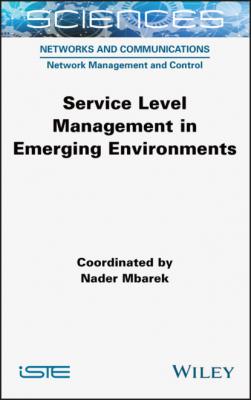ТОП просматриваемых книг сайта:
Service Level Management in Emerging Environments. Nader Mbarek
Читать онлайн.Название Service Level Management in Emerging Environments
Год выпуска 0
isbn 9781119818328
Автор произведения Nader Mbarek
Жанр Отраслевые издания
Издательство John Wiley & Sons Limited
257 254
258 255
259 256
260 257
261 259
SCIENCES
Networks and Communications, Field Director – Guy Pujolle
Network Management and Control, Subject Head – Francine Krief
Service Level Management in Emerging Environments
Coordinated by
Nader Mbarek
First published 2020 in Great Britain and the United States by ISTE Ltd and John Wiley & Sons, Inc.
Apart from any fair dealing for the purposes of research or private study, or criticism or review, as permitted under the Copyright, Designs and Patents Act 1988, this publication may only be reproduced, stored or transmitted, in any form or by any means, with the prior permission in writing of the publishers, or in the case of reprographic reproduction in accordance with the terms and licenses issued by the CLA. Enquiries concerning reproduction outside these terms should be sent to the publishers at the undermentioned address:
ISTE Ltd
27-37 St George’s Road
London SW19 4EU
UK
John Wiley & Sons, Inc.
111 River Street
Hoboken, NJ 07030
USA
© ISTE Ltd 2020
The rights of Nader Mbarek to be identified as the author of this work have been asserted by him in accordance with the Copyright, Designs and Patents Act 1988.
Library of Congress Control Number: 2020933380
British Library Cataloguing-in-Publication Data
A CIP record for this book is available from the British Library ISBN 978-1-78945-002-6
ERC code:
PE7 Systems and Communication Engineering
PE7_1 Control engineering
PE7_8 Networks (communication networks, sensor networks, networks of robots, etc.)
Preface
Nader MBAREK
LIB, University of Bourgogne Franche-Comté, Dijon, France
Communication technology has changed so much in our time that networks are omnipresent, with a variety of access equipment that allow people to constantly communicate with the network in order to produce or benefit from services provided by the network using ever-increasing and ever-more dynamic applications and operating environments. Networks have become an embedded part of daily life. This has been possible thanks to components that are constantly becoming smaller, cheaper and more powerful with higher processing speeds. Most important, perhaps, is that these components are able to form more and more connections between themselves using different technologies, thereby forming ambient networks on a large scale. In parallel with this quantitative explosion in communication networks, there is a complexification of technology. This rise in the number of networks and their complexity is accompanied by challenges in terms of management and control. Further, the increased competitiveness between service providers and the constant change in user needs requires genuine “dynamism” in service offerings, which is moving more toward Quality of Service (QoS), mobility and security as access networks and the technologies used develop further, while also trying to offer different service levels, thus responding to the needs of different types of applications. In this context, it becomes necessary to manage the service level demanded by the client and that the service provider must commit to offering. This service level is then used to efficiently parametrize the resources managed by the service provider based on customer needs.
It is from this point of view that different approaches for managing one or more service level components (QoS, security and mobility) are described in this book for different emerging environments such as the Internet of Things (IoT), the Cloud, smart grids, e-health, mesh networking, device to device (D2D), smart cities and green networking.
In Chapter 1, Ahmad Khalil, Nader Mbarek and Olivier Togni introduce the IoT environment through architectures proposed by different standardization bodies. They describe the importance of managing security and the protection of privacy in this kind of environment. Further, the authors highlight the needs and requirements of each layer in the IoT architecture in terms of QoS as well as in terms of the proposed QoS mechanisms that can respond to these requirements. Finally, a framework that uses a three-layer IoT architecture and a QoS-based access mechanism concerning the lowest level in this architecture are described.
In Chapter 2, Nader Mbarek describes the Cloud environment in terms of Cloud Computing, Cloud Networking and inter-Cloud. The author specifies the context and motives around guaranteeing service level in the Cloud in terms of QoS and security. A framework for guaranteeing the QoS in the Cloud Networking environment is introduced.
In Chapter 3, Samira Chouikhi, Leila Merghem-Boulahia and Moez Esseghir explore demand management as a service offered to consumers in a smart grid environment. They describe this environment and its essential components and also explain fundamental concepts of demand management. They focus on demand-side management, more specifically on energy consumption planning.
In Chapter 4, Mohamed-Aymen Chalouf introduces e-health systems, offering an overview of their architecture and characteristics. The author then describes the security and QoS challenges in this kind of environment and discusses several research papers and projects aimed at providing appropriate management solutions.
In Chapter 5, Hajer Bargaoui, Nader Mbarek and Olivier Togni introduce characteristics of wireless mesh networking, highlighting QoS management. The authors define routing concepts based on QoS in wireless mesh networks and describe Hybrid QoS Mesh Routing (HQMR) as an example of a routing protocol based on the defined QoS for this kind of environment.
In Chapter 6, Axel Moinet and Benoît Darties introduce the concept of blockchain through its basic characteristics and operating principle. The authors then describe how blockchain can fit into a model dedicated to the IoT in order to respond to authentication and trust challenges in this kind of environment. Blockchain Authentication and Trust Module (BATM) architecture is introduced as a solution that can respond to these challenges.
In Chapter 7, Chérifa Boucetta, Hassine Moungla and Hossam Afifi describe the emergence of D2D communications, focusing

